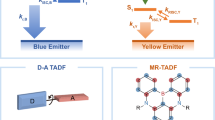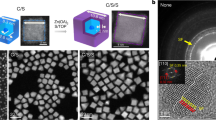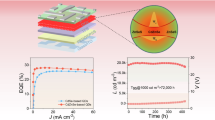Abstract
White light-emitting diodes based on single-component quantum dots (sc-WQLEDs) have gained great attention owing to their low operating voltage and the high spectral stability of their emission. However, their performance presently lags far behind that of state-of-the-art white organic LEDs owing to a lack of efficient white quantum dot emitters. Creating self-trapped excitons in semiconductor quantum dots is a promising approach to producing broadband white emission. However, such emitters generally suffer from poor charge transport and structural instability. Here we accomplish controllable synthesis of core/shell structured ZnSe/ZnS quantum dots with efficient white emission through combining a sharp excitonic blue emission with a broadband yellow self-trapped exciton emission owing to local lattice softening of ZnSe cores by heterovalent doping with halogen ions. We reveal that the self-trapped excitons confined in the surrounding ZnSe covalent-bond matrix can generate strong and stable yellow emission with minimal reduction of the excitonic blue emission and charge transport capability of ZnSe. On the basis of this approach, we demonstrate highly efficient, heavy-metal-free WQLEDs with a maximum external quantum efficiency up to 15% (average 10.5 ± 2.6%), a luminance of over 26,000 cd m−2 as well as exceptional device operational lifetime with T50 exceeding 2,500 h at an initial luminance of 100 cd m−2.
This is a preview of subscription content, access via your institution
Access options
Access Nature and 54 other Nature Portfolio journals
Get Nature+, our best-value online-access subscription
$32.99 / 30 days
cancel any time
Subscribe to this journal
Receive 12 print issues and online access
$259.00 per year
only $21.58 per issue
Buy this article
- Purchase on SpringerLink
- Instant access to full article PDF
Prices may be subject to local taxes which are calculated during checkout




Similar content being viewed by others
Data availability
The data supporting the findings of this study are available within the article and its Supplementary Information. The source data files are available via figshare at https://doi.org/10.6084/m9.figshare.29107793.v1 (ref. 60). Source data are provided with this paper.
References
Kim, T. et al. Efficient and stable blue quantum dot light-emitting diode. Nature 586, 385–389 (2020).
Shen, H. et al. Visible quantum dot light-emitting diodes with simultaneous high brightness and efficiency. Nat. Photon. 13, 192–197 (2019).
Qian, L., Zheng, Y., Xue, J. & Holloway, P. H. Stable and efficient quantum-dot light-emitting diodes based on solution-processed multilayer structures. Nat. Photon. 5, 543–548 (2011).
Li, X. et al. Bright colloidal quantum dot light-emitting diodes enabled by efficient chlorination. Nat. Photon. 12, 159–164 (2018).
Jang, E. & Jang, H. Review: quantum dot light-emitting diodes. Chem. Rev. 123, 4663–4692 (2023).
Deng, Y. et al. Solution-processed green and blue quantum-dot light-emitting diodes with eliminated charge leakage. Nat. Photon. 16, 505–511 (2022).
Won, Y.-H. et al. Highly efficient and stable InP/ZnSe/ZnS quantum dot light-emitting diodes. Nature 575, 634–638 (2019).
Sun, R. et al. Efficient single-component white light emitting diodes enabled by lanthanide ions doped lead halide perovskites via controlling Förster energy transfer and specific defect clearance. Light Sci. Appl. 11, 340 (2022).
Kim, J.-H. et al. Tunable emission of bluish Zn-Cu-Ga-S quantum dots by Mn doping and their electroluminescence. ACS Appl. Mater. Interfaces 11, 8250–8257 (2019).
Zhu, J. et al. Tunable emission of Cu (Mn)-doped ZnInS quantum dots via dopant interaction. J. Colloid Interface Sci. 506, 27–35 (2017).
Zhang, W.-J., Pan, C.-Y., Cao, F., Wang, H. & Yang, X. Highly bright and stable white-light-emitting cadmium-free Ag,Mn co-doped Zn–In–S/ZnS quantum dots and their electroluminescence. J. Mater. Chem. C 6, 10233–10240 (2018).
Bae, W. K. et al. R/G/B/natural white light thin colloidal quantum dot-based light-emitting devices. Adv. Mater. 26, 6387–6393 (2014).
Cho, Y., Pak, S., Li, B., Hou, B. & Cha, S. Enhanced direct white light emission efficiency in quantum dot light-emitting diodes via embedded ferroelectric islands structure. Adv. Funct. Mater. 31, 2104239 (2021).
Zhang, H., Su, Q. & Chen, S. Quantum-dot and organic hybrid tandem light-emitting diodes with multi-functionality of full-color-tunability and white-light-emission. Nat. Commun. 11, 2826 (2020).
Zhang, Y. et al. Lead-free double perovskite Cs2AgIn0.9Bi0.1Cl6 quantum dots for white light-emitting diodes. Adv. Sci. 9, 2102895 (2022).
Sun, R. et al. Samarium-doped metal halide perovskite nanocrystals for single-component electroluminescent white light-emitting diodes. ACS Energy Lett. 5, 2131–2139 (2020).
Zhang, W.-J., Pan, C.-Y., Cao, F. & Yang, X. White-light-emitting Cu,Mn co-doped Zn-In-S/ZnS quantum dots with high stability and their electroluminescence. J. Mater. Chem. C 5, 10533–10542 (2017).
Kim, J.-H. et al. White electroluminescent lighting device based on a single quantum dot emitter. Adv. Mater. 28, 5093–5098 (2016).
Schreuder, M. A., Xiao, K., Ivanov, I. N., Weiss, S. M. & Rosenthal, S. J. White light-emitting diodes based on ultrasmall CdSe nanocrystal electroluminescence. Nano Lett. 10, 573–576 (2010).
Rosson, T. E., Claiborne, S. M., McBride, J. R., Stratton, B. S. & Rosenthal, S. J. Bright white light emission from ultrasmall cadmium selenide nanocrystals. J. Am. Chem. Soc. 134, 8006–8009 (2012).
Wu, H. et al. Single component Mn-doped perovskite-related CsPb2ClxBr5−x nanoplatelets with a record white light quantum yield of 49%: a new single layer color conversion material for light-emitting diodes. Nanoscale 9, 16858–16863 (2017).
Dolai, S., Dutta, P., Muhoberac, B. B., Irving, C. D. & Sardar, R. Mechanistic study of the formation of bright white light-emitting ultrasmall CdSe nanocrystals: role of phosphine free selenium precursors. Chem. Mater. 27, 1057–1070 (2015).
Song, S.-W. et al. Single and dual doping of blue-emissive ZnSeTe quantum dots with transition metal ions. Adv. Opt. Mater. 10, 2101767 (2022).
Xu, Z. et al. Toward a general understanding of exciton self-trapping in metal halide perovskites. J. Phys. Chem. Lett. 12, 10472–10478 (2021).
Guo, Q., Zhao, X., Song, B., Luo, J. & Tang, J. Light emission of self-trapped excitons in inorganic metal halides for optoelectronic applications. Adv. Mater. 34, 2201008 (2022).
Chen, J. et al. Efficient and bright white light-emitting diodes based on single-layer heterophase halide perovskites. Nat. Photon. 15, 238–244 (2020).
Luo, J. et al. Efficient and stable emission of warm-white light from lead-free halide double perovskites. Nature 563, 541–545 (2018).
Shi, Y., Zhao, W., Ma, Z., Xiao, G. & Zou, B. Self-trapped exciton emission and piezochromism in conventional 3D lead bromide perovskite nanocrystals under high pressure. Chem. Sci. 12, 14711–14717 (2021).
Cho, J., Mathew, P. S., DuBose, J. T. & Kamat, P. V. Photoinduced halide segregation in Ruddlesden–Popper 2D mixed halide perovskite films. Adv. Mater. 33, 2105585 (2021).
Zhou, B. et al. Efficient white photoluminescence from self-trapped excitons in Sb3+/Bi3+-codoped Cs2NaInCl6 double perovskites with tunable dual-emission. ACS Energy Lett. 6, 3343–3351 (2021).
Sun, F. et al. Top-emitting microcavity light-emitting diodes based on all-thermally evaporated lead-free copper halide self-trapped-exciton emitters. J. Phys. Chem. Lett. 13, 3431–3437 (2022).
Wang, C. S. & Klein, B. M. First-principles electronic structure of Si, Ge, GaP, GaAs, ZnS, and ZnSe. II. Optical properties. Phys. Rev. B 24, 3417–3429 (1981).
Maruyama, T., Ogawa, T., Akimoto, K. & Kitajima, Y. Extended X-ray absorption fine structure study of defects in Cl doped ZnSe. Solid State Commun. 103, 453–457 (1997).
Liu, S., Rong, C., Lu, T. & Hu, H. Identifying strong covalent interactions with Pauli energy. J. Phys. Chem. A 122, 3087–3095 (2018).
Vikram, A. et al. Unraveling the origin of interfacial oxidation of InP-based quantum dots: implications for bioimaging and optoelectronics. ACS Appl. Nano Mater. 3, 12325–12333 (2020).
Dorji, P. et al. Bromide and iodide selectivity in membrane capacitive deionisation, and its potential application to reduce the formation of disinfection by-products in water treatment. Chemosphere 234, 536–544 (2019).
Zhang, Q. et al. Lead zinc slag-based geopolymer: demonstration of heavy metal solidification mechanism from the new perspectives of electronegativity and ion potential. Environ. Pollut. 293, 118509 (2022).
Chai, S., Wen, S.-H., Huang, J.-D. & Han, K.-L. Density functional theory study on electron and hole transport properties of organic pentacene derivatives with electron-withdrawing substituent. J. Comput. Chem. 32, 3218–3225 (2011).
Yang, Y. et al. Shape control of colloidal Mn doped ZnO nanocrystals and their visible light photocatalytic properties. Nanoscale 5, 10461–10471 (2013).
Liu, Y., Cullen, D. A. & Lian, T. Slow Auger recombination of trapped excitons enables efficient multiple electron transfer in CdS-Pt nanorod heterostructures. J. Am. Chem. Soc. 143, 20264–20273 (2021).
Zhou, R. et al. Multiphoton excited singlet/triplet mixed self-trapped exciton emission. Nat. Commun. 14, 1310 (2023).
Cong, M. et al. Self-trapped exciton engineering for white-light emission in colloidal lead-free double perovskite nanocrystals. Sci. Bull. 65, 1078–1084 (2020).
Cong, M. et al. Bright triplet self-trapped excitons to dopant energy transfer in halide double-perovskite nanocrystals. Nano Lett. 21, 8671–8678 (2021).
Tan, J. et al. Self-trapped excitons in soft semiconductors. Nanoscale 14, 16394–16414 (2022).
Benin, B. M. et al. Highly emissive self-trapped excitons in fully inorganic zero-dimensional tin halides. Angew. Chem. Int. Ed. 57, 11329–11333 (2018).
Parto, K., Azzam, S. I., Banerjee, K. & Moody, G. Defect and strain engineering of monolayer WSe2 enables site-controlled single-photon emission up to 150 K. Nat. Commun. 12, 3585 (2021).
Peng, H. & Zou, B. Effects of electron–phonon coupling and spin–spin coupling on the photoluminescence of low-dimensional metal halides. J. Phys. Chem. Lett. 13, 1752–1764 (2022).
Sharma, V. & Mehata, M. S. A parallel investigation of un-doped and manganese ion-doped zinc selenide quantum dots at cryogenic temperature and application as an optical temperature sensor. Mater. Chem. Phys. 276, 125349 (2022).
Wu, K. et al. Temperature-dependent excitonic photoluminescence of hybrid organometal halide perovskite films. Phys. Chem. Chem. Phys. 16, 22476–22481 (2014).
Wang, S. et al. Temperature-dependent band gap in two-dimensional perovskites: thermal expansion interaction and electron–phonon interaction. J. Phys. Chem. Lett. 10, 2546–2553 (2019).
Chen, H.-Y., Maiti, S., Nelson, C. A., Zhu, X. & Son, D. H. Tuning temperature dependence of dopant luminescence via local lattice strain in core/shell nanocrystal structure. J. Phys. Chem. C 116, 23838–23843 (2012).
Zhang, S., Wang, L., Wang, Y., Wang, X. & Ye, S. Satellite red emission from a single green emissive MnBr42− tetrahedron in soft hybrid single crystals. J. Phys. Chem. Lett. 14, 7773–7779 (2023).
Fabini, D. H. et al. Reentrant structural and optical properties and large positive thermal expansion in perovskite formamidinium lead iodide. Angew. Chem. 128, 15618–15622 (2016).
Zhao, H. & Kalt, H. Energy-dependent Huang-Rhys factor of free excitons. Phys. Rev. B 68, 125309 (2003).
Gong, K., Kelley, D. F. & Kelley, A. M. Resonance Raman spectroscopy and electron-phonon coupling in zinc selenide quantum dots. J. Phys. Chem. C 120, 29533–29539 (2016).
Wang, Z. et al. Boosting the self-trapped exciton emission in Cs2NaYCl6 double perovskite single crystals and nanocrystals. J. Phys. Chem. Lett. 13, 8613–8619 (2022).
Heyd, J., Scuseria, G. E. & Ernzerhof, M. Hybrid functionals based on a screened Coulomb potential. J. Chem. Phys. 118, 8207–8215 (2003).
Görling, A. Density-functional theory beyond the Hohenberg-Kohn theorem. Phys. Rev. A 59, 3359–3374 (1999).
Du, M.-H. Using DFT methods to study activators in optical materials. ECS J. Solid State Sci. Technol. 5, R3007 (2016).
Wang, S. et al. Datasets for ‘Local lattice softening in semiconductor quantum dots for efficient white light-emitting diodes’. figshare https://doi.org/10.6084/m9.figshare.29107793.v1 (2025).
Acknowledgements
X.Y. acknowledges financial support from the National Key Research and Development Program of China (project 2022YFB3602902 and 2024YFB3612404), the National Natural Science Foundation of China (62174104), the Shanghai Science and Technology Committee (19010500600), and the Program for Professor of Special Appointment (Eastern Scholar) at Shanghai Institutions of Higher Learning. G.J. acknowledges the Australian Research Council (ARC) Future Fellowship Scheme (FT210100509). S.S. and X.G. acknowledge funding support from the University of Michigan and NSF grant #DMR-1625671. L.D. acknowledges funding support from UKRI Horizon Europe Guarantee MSCA Marie Skłodowska-Curie Postdoctoral Fellowship (EP/Y029429/1). S.D.S. acknowledges the Royal Society and Tata Group (grant numbers UF150033, URF\R\221026). L.D. and S.D.S acknowledge the European Research Council (ERC) under the European Union’s Horizon 2020 research and innovation programme (HYPERION, grant agreement no. 756962).
Author information
Authors and Affiliations
Contributions
X.Y. conceived the idea and guided the whole project. S.W. designed and performed most of the experiments, analysed the data and wrote the paper. C.W., B.L. and L.D. carried out the TA and PDS, analysed the data and helped in paper writing. Y.W. and H.W. helped with the material synthesis and characterization. T.L. contributed to the device optimization. H.S. and W.Z. performed the HAADF-STEM measurement. C.W. and Z.L. contributed to the DFT calculations under supervision from G.Z. Jiayi Chen contributed to element mapping under supervision from G.J. S.S. analysed the temperature-dependent PL data. X.Y., X.G., Q.W., Jianhua Zhang, L.D., B.L., G.J., L.W., Jun Chen, X.B., Jiaqi Zhang, S.D.S. and R.H.F. prepared and polished the paper. All authors contributed to the discussion and review of the paper.
Corresponding authors
Ethics declarations
Competing interests
The authors declare no competing interests.
Peer review
Peer review information
Nature Photonics thanks Eunjoo Jang and the other, anonymous, reviewer(s) for their contribution to the peer review of this work.
Additional information
Publisher’s note Springer Nature remains neutral with regard to jurisdictional claims in published maps and institutional affiliations.
Extended data
Extended Data Fig. 1 Local lattice softening in Cl:ZnSe.
a, b, Comparison of the equilibrium geometric structures of pristine ZnSe between (a) GS and (b) ES. c, d, Comparison of equilibrium geometric structures near ClSe-VZn2− region of Cl:ZnSe between (c) GS and (d) ES. Upon photoexcitation, the Cl-Cl and Se-Se bond contract.
Extended Data Fig. 2 Exciton distribution variations induced by local soft lattices in ES.
Exciton density distributions for a, ZnSe and b, Cl:ZnSe.
Extended Data Fig. 3 Characterization for single-component white emissions.
a, PL mapping of Cl:ZnSe/ZnSe/ZnS QDs using filters of 420-480 nm and 495-550 nm, respectively. These filters enable the detection of emission occurring within their respective wavelength ranges. The individual QDs (circled in green) exhibit distinct bright dots under both filters, indicating that the white emissions originate from the same particle. b, PL intensity time trace of Cl:ZnSe/ZnSe/ZnS QDs for the two emissions detected by the aforementioned filters, respectively. The non-blinking behavior observed for each emission peak suggests the effective suppression of Auger combination process. The excited wavelength used is 405 nm. c, Photoluminescence excitation (PLE) spectra of Cl:ZnSe/ZnSe/ZnS QDs with different PL wavelengths covering the entire PL spectra. These PLE spectral profiles are almost identical, which rule out the possibility that the multiple emissions result from the radiation ensemble of different emitters. This observation is consistent with the fact that the optimal excitation wavelength varies for different materials. Any other scenario would result in a variation in the excitation spectrum with changes in the detection wavelength. d, PL spectra of Cl:ZnSe/ZnSe/ZnS QDs under varying excitation light. The insert provides a zoom-in view of the low-energy emission region under excitation wavelengths ranging from 470 to 650 nm. It is discernible that the broadband emissions vanish when the excitation wavelengths exceed 500 nm, illustrating that the low-energy emission is dependent on the energy or charge transfer from ZnSe host.
Extended Data Fig. 4 Temperature-dependent PL measurement.
2D colour map of temperature-dependent PL spectra of a, pristine ZnSe/ZnS QDs and b, Cl:ZnSe/ZnSe/ZnS QDs, respectively. The temperature stable PL emissions of Cl doped QDs may result from a combined effect of reduced thermal expansion and enhanced energy transfer from the FE to the STE states.
Extended Data Fig. 5 Performance of the champion sc-WQLED.
a, J-V-L and b, L-EQE characteristics. Inset shows the EL spectrum of the device.
Supplementary information
Supplementary Information
Supplementary Figs. 1–22 and Tables 1–3.
Source data
Source Data Fig. 1
Statistical source data.
Source Data Fig. 2
Statistical source data.
Source Data Fig. 3
Statistical source data.
Source Data Fig. 4
Statistical source data.
Source Data Extended Data Fig. 3
Statistical source data.
Source Data Extended Data Fig. 4
Statistical source data.
Source Data Extended Data Fig. 5
Statistical source data.
Rights and permissions
Springer Nature or its licensor (e.g. a society or other partner) holds exclusive rights to this article under a publishing agreement with the author(s) or other rightsholder(s); author self-archiving of the accepted manuscript version of this article is solely governed by the terms of such publishing agreement and applicable law.
About this article
Cite this article
Wang, S., Wang, C., Wang, Y. et al. Local lattice softening in semiconductor quantum dots for efficient white light-emitting diodes. Nat. Photon. 19, 952–959 (2025). https://doi.org/10.1038/s41566-025-01716-y
Received:
Accepted:
Published:
Issue date:
DOI: https://doi.org/10.1038/s41566-025-01716-y



